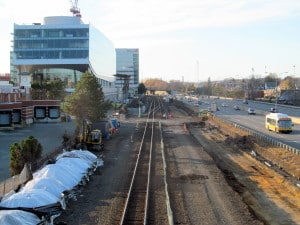It’s got to be tough to be head of your local trade group, whether it’s representing retailers, construction contractors or, in the case of David Begelfer, real estate developers.
Many trade association chiefs are either afraid of saying anything remotely meaningful out of fear of angering the odd member or two. Or, on the other extreme, they are so heatedly fixated on the group’s goals they sound like as if they are frothing at the mouth and ready to blow over some minor regulatory beef.
But Begelfer, who recently announced plans to retire as head of NAIOP Massachusetts after nearly three decades on the job, has never had much of a problem striking the right note, unafraid to address controversial issues and often a voice of reason in a region and a state in which new development proposals – and NIMBY opposition to them – can be a blood sport.
He has even managed to keep a sense of humor about it all.
I caught up with Begelfer the other day and found him relatively upbeat about the Bay State’s economic future and the development boom that is remaking Boston and its environs, but not without some serious concerns about the threat posed by our increasingly unaffordable housing market.
Past booms were great – think the late ’90s and mid-2000s – but we’re now in uncharted territory. Don’t just take Begelfer’s word for it – as I noted in a recent interview with Brian Golden, head of the Boston Planning and Development Agency.
Boston has given the green light to 199 new office towers, hotels, retail projects and lab complexes, among other uses, since the start of 2014. From 2005 through 2013, 201 projects were approved, according to the BPDA.
Of the 24 million square feet in new office space given the OK by City Hall since 2005, roughly 15 million of it has been approved since 2014.
On top of that, we now have new development frontiers opening up in places that a few years ago no one would have imagined, such as Suffolk Downs and the old Boston Globe building on Morrissey Boulevard.
“Today’s market, the Greater Boston economy and the commercial real estate environment has never been as dynamic and exciting as it is now,” Begelfer said. “This is really unique time.”

Scott Van Voorhis
Building Boom
The pluses are there for all to see: we have a diverse and thriving local economy powered by biotech, tech, health care, research and higher education, just to name the leading sectors. Major companies like GE are seeking out the Boston area for its pool of talent, moving headquarters and research operations alike.
And the commercial real estate market is in particularly solid shape, with tight office vacancy rates and investors relying on cash instead of mountains of debt to acquire new towers and buildings, he noted.
Yes, there is there a boom in new development, from condominium towers to new corporate high-rises. But real estate firms are also pumping tens of millions of dollars into renovations of existing towers, glamming up lobbies and upgrading towers across the city to coveted, Class A status.
And while a downturn at some point is inevitable, Begelfer doesn’t see anything on the horizon for two or three years.
Rather, he sees the biggest threat to the Boston area economy and real estate market coming from its success and the challenges this creates. In particular, a record amount of construction activity has left developers and contractors scrambling to find workers and faced with costs rising faster than they can raise rents or condo prices.
The region’s long-standing housing crunch has only further exacerbated the labor shortage. Given what has happened to rents and prices in the Boston area over the past years and decades, no construction worker in his or her right mind is about to move here from Oklahoma or Texas.
“Substantially rising construction costs and land costs are making projects less viable,” Begelfer said. “Our biggest threat is success, not a recession.”
Zoning Reform Fight Continues
It’s not just in the construction market where the housing crisis spells trouble for the region’s labor market and the ability to attract and retain middle-class families in particular.
When it comes to domestic migration to and from Massachusetts from other states, we have been on the losing end for the most part for years now, Begelfer noted.
Only an influx of immigrants from other countries has kept the labor pool growing, and that source, given the Trump Administration’s crackdown on immigration, is obviously under duress.
Unfortunately, the one area where Begelfer is not so optimistic about is the Boston area’s ability to build the large amounts of new homes, condos and apartments needed to stabilize prices and prevent its priced-out middle class from fleeing entirely.
A major overhaul of local zoning barriers is needed. Failing that, expanding 40B to enable developers to cut through local regulations in order to build an even wider array of housing is another idea.
But neither is politically practicable in Begelfer’s view, with the politics of zoning reform “the third rail” of Massachusetts politics.
I surely hope he’s wrong, though I do agree with Begelfer’s assessment of the daunting political challenges facing any legislative leader or governor who attempts real, as opposed to Potemkin, zoning reform.
Luckily, we will still be hearing from Begelfer on issues facing the development sector and beyond. While he will retire at the end of the year, Begelfer intends to remain and active member of NAIOP and may do some private sector consulting.
See you around, David. Somehow I don’t think you will be staying quiet for long.
Scott Van Voorhis is Banker & Tradesman’s columnist; opinions expressed are his own. He may be reached at sbvanvoorhis@hotmail.com.




 |
| 

